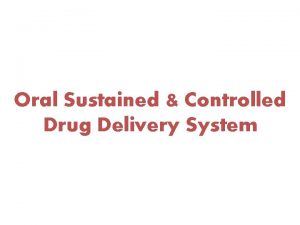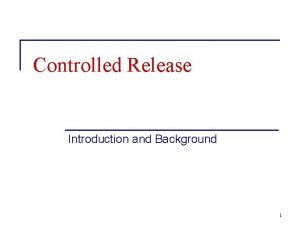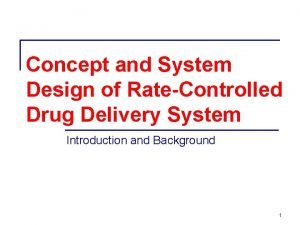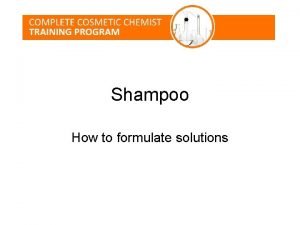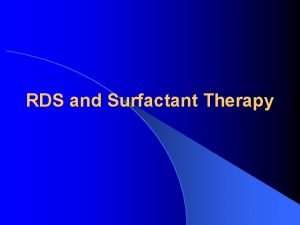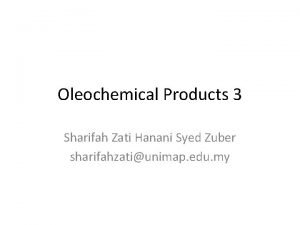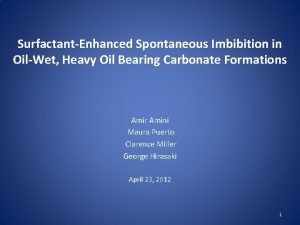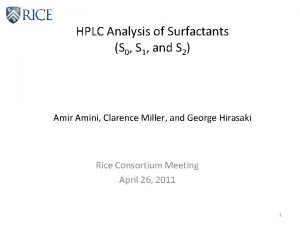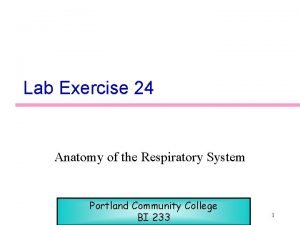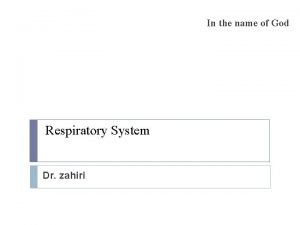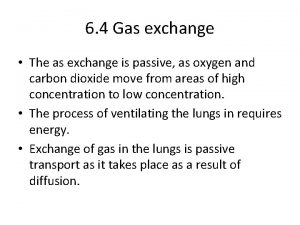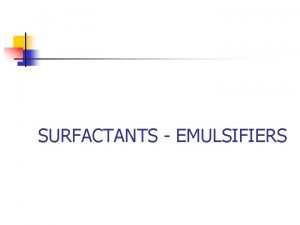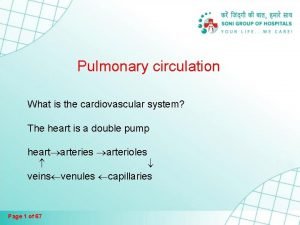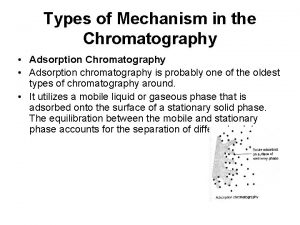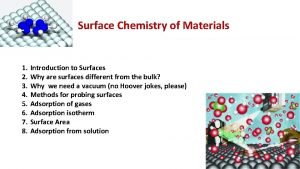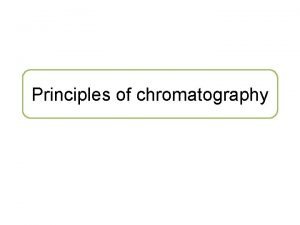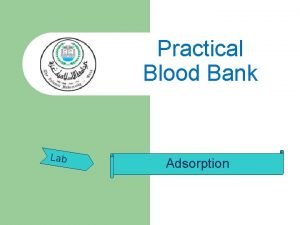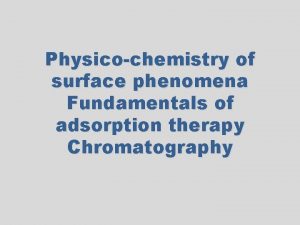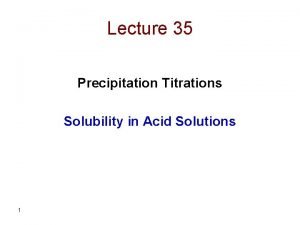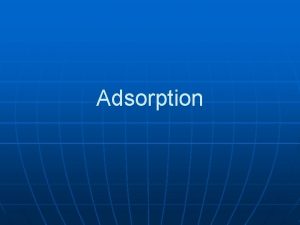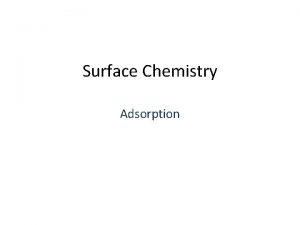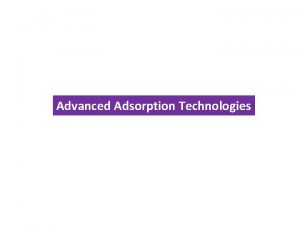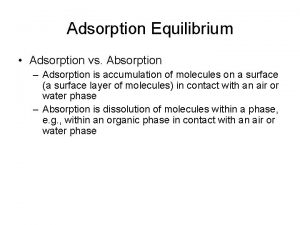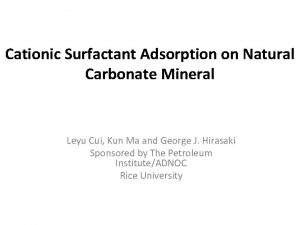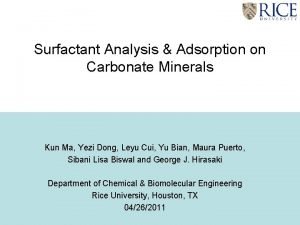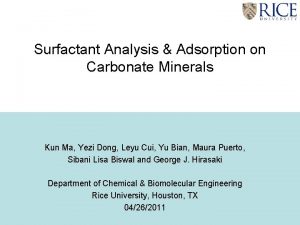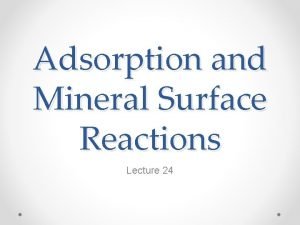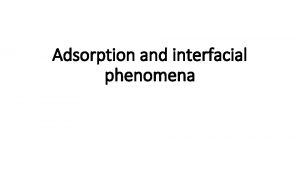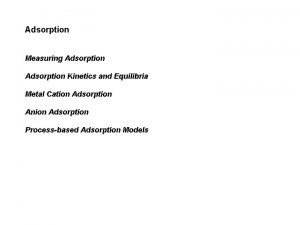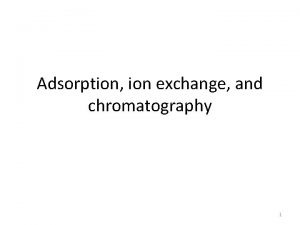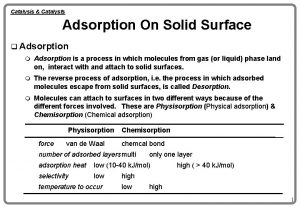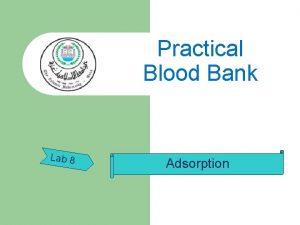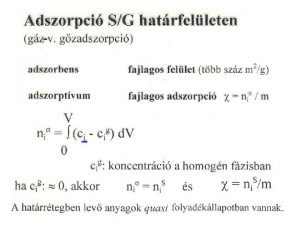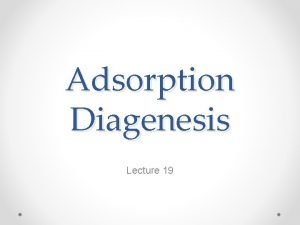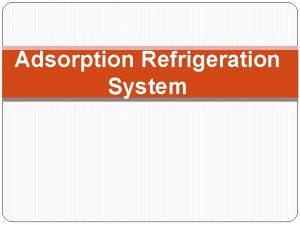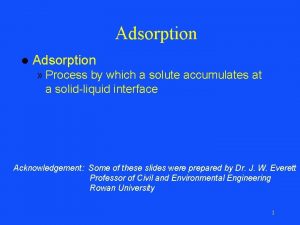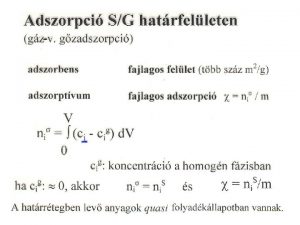Adsorption and Release of Surfactant into and from

















![References [1] [2] [3] [4] [5] [6] [7] [8] [9] [10] [11] [12] [13] References [1] [2] [3] [4] [5] [6] [7] [8] [9] [10] [11] [12] [13]](https://slidetodoc.com/presentation_image_h/12bb4fa7f111b07b1dcd6fdb4b198900/image-18.jpg)
![Materials: ZI-MG synthesis › Co-monomers – N-isopropylacrylamide (NIPAm, Acros) – N-[3 -(dimethylamino)propyl] methacrylamide (DMAPMA, Materials: ZI-MG synthesis › Co-monomers – N-isopropylacrylamide (NIPAm, Acros) – N-[3 -(dimethylamino)propyl] methacrylamide (DMAPMA,](https://slidetodoc.com/presentation_image_h/12bb4fa7f111b07b1dcd6fdb4b198900/image-19.jpg)



- Slides: 22

Adsorption and Release of Surfactant into and from Multifunctional Zwitterionic Poly(NIPAm-co-DMAPMA-co-AAc) Microgel Particles Morgan Kelley Haobo Chen Dr. Lenore L. Dai Ira A. Fulton Schools of Engineering Arizona State University

Motivation and Goals Oil spills are dangerous to marine life and the environment, and chemicals commonly used to disperse these spills can also be detrimental to aquatic health. This project develops a method of transporting these dispersants via Zwitterionic microgels (ZI-MG) The goals of this experiment are to investigate the properties of ZI-MG dispersions and their capabilities as novel carrier systems by investigating their propensity for uptake and release of various surfactants. 2/25/2021 ARIZONA STATE UNIVERSITY 2

About ZI-MG › Environmentally responsive – p. H – Temperature › Tunable parabolic size changes › Dually positive and negatively charged › Able to uptake and release active species into and from surrounding fluid 2/25/2021 ARIZONA STATE UNIVERSITY 3

Surfactants › Surface Active Agents › Hydrophobic tail › Hydrophilic head – Cationic – Anionic – Nonionic › Lower the surface tension of water › Hydrophobic tails arrange around hydrophobic entities within the bulk 2/25/2021 ARIZONA STATE UNIVERSITY 4

Methods: ZI-MG Synthesis › DMAPMA and AAc comonomers were copolymerized with NIPAm via free radical precipitation polymerization Nitrogen Out › DMAPMA, NIPAm, AAc, MBAm, SDS, and HPLC put in 3 -neck roundbottom flask and degassed with nitrogen for 30 minutes › 5 g of HPLC with KPS initiator dissolved added after 30 minutes › Polymerization proceeded for 8 hours under nitrogen at 70 o. C Water out Water in KPS in Nitrogen in › Dialyzed against deionized water to remove unreacted monomers 2/25/2021 ARIZONA STATE UNIVERSITY 5

Characterization of ZI-MG › Dynamic Light Scattering (DLS) – – – p. H ramp Temperature ramp PSS-NICOMP 380 ZLS Measures intensity of laser coming through particles Particle size calculated by Stokes-Einstein in program › Zeta Potential (ZLS) – p. H ramp – Measures electrophoretic mobility between electrodes – Electrophoretic Light Scattering 2/25/2021 ARIZONA STATE UNIVERSITY 6

Characterization of ZI-MG: p. H Responsiveness › Initial size decrease due to electrostatic attraction of AAc and DMAPMA › Charge neutralized at IEP › Past the IEP there is size increase due to electrostatic repulsion between AAc and DMAPMA > 2/25/2021 IEP for 0. 85 is later than that of 0. 29 due to increased DMAPMA and (more added base required to neutralize) ARIZONA STATE UNIVERSITY 7

Characterization of ZI-MG: p. H Responsiveness › Decrease in ζ-potential verifies size change prior to IEP › Charge neutralized at the IEP › ζ-potential decreases with p. H due to deprotonation of both DMAPMA and AAc 2/25/2021 › ζ-potential increases with p. H following IEP – Further deprotonation of AAc and DMAPMA results in repulsion ARIZONA STATE UNIVERSITY 8

Characterization of ZI-MG: Temperature Responsiveness › Temperature transition and VPTT due to NIPAm › VPTT can be shifted by increasing DMAPMA: AAc ratio 2/25/2021 › 0. 85 has more gradual decrease – More balanced composition and stable ion pairs – 0. 29 has less ion coupling and is thus less stable ARIZONA STATE UNIVERSITY 9

Materials: Surfactant Uptake › Anionic surfactant Dioctyl Sodium Sulfosuccinate (DOSS, Sigma-Aldrich), › Cationic surfactant Cetylpyridinium Chloride (CPy. Cl, Fluka) and › Nonionic surfactant Trition. TM X 100 (TX-100, Sigma-Aldrich) were also used as received. DOSS TX-100 CPy. Cl 2/25/2021 ARIZONA STATE UNIVERSITY 10

Surfactant Uptake: Anionic DOSS > > Average size and electrophoretic mobility of p. H 11 ZI-MG is unvarying with DOSS concentration Size of p. H 3 decreases with added DOSS > Electrostatic attraction of positively charged DMAPMA to DOSS 2/25/2021 > > Swelling beyond CAC due to particle flocculation Electrophoretic mobility decreases with added DOSS > > Positively charged DMAPMA is neutralized by anionic DOSS Electrophoretic mobility increase beyond CMC due to DOSS binding ARIZONA STATE UNIVERSITY 11

Surfactant Uptake and Release: Anionic DOSS 2/25/2021 ARIZONA STATE UNIVERSITY 12

Surfactant Uptake: Cationic CPy. Cl › Diameter and electrophoretic mobility unvarying for p. H 3 › Diameter decreases with CPy. Cl for p. H 11 – Due to electrostatic attraction of negatively charged ZI-MG to 2/25/2021 CPy. Cl – Electrophoretic mobility increases with added CPy. Cl for p. H 11 – Solution becomes neutralized with enough added CPy. Cl due to ion pairing ARIZONA STATE UNIVERSITY 13

Surfactant Release: CPy. Cl >Fixed amount of CPy. Cl in solution >Decrease in p. H shows that less surfactant was absorbed into ZI-MG >Since there is a fixed amount in solution, this denotes release >Higher fixed CPy. Cl concentration enabled more absorption 2/25/2021 ARIZONA STATE UNIVERSITY 14

Conclusion and Future Work › ZI-MG particles were synthesized which change size and charge according to environmental stimuli › Cationic, and nonionic surfactants were studied for uptake capabilities – Cationic CPy. Cl was uptaken at p. H 11 – Anionic CPy. Cl was uptaken at p. H 3 and released at p. H 11 › Future research: – Investigation of temperature effects on surfactant uptake – Synthesis of magnetic core-shell ZI-MG particles for easy removal from solution 2/25/2021 ARIZONA STATE UNIVERSITY 15

Acknowledgements Dr. Lenore L Dai and Haobo Chen Colloid and Interfacial Science and Engineering Lab at Arizona State University Research Funding: Gulf of Mexico Research Initiative (Go. MRI) Fulton Undergraduate Research Initiative (FURI) ASU/NASA Space Grant 2/25/2021 ARIZONA STATE UNIVERSITY 16

Thank You! › Questions? 2/25/2021 ARIZONA STATE UNIVERSITY 17
![References 1 2 3 4 5 6 7 8 9 10 11 12 13 References [1] [2] [3] [4] [5] [6] [7] [8] [9] [10] [11] [12] [13]](https://slidetodoc.com/presentation_image_h/12bb4fa7f111b07b1dcd6fdb4b198900/image-18.jpg)
References [1] [2] [3] [4] [5] [6] [7] [8] [9] [10] [11] [12] [13] C. Zhao, X. Gao, P. He, C. Xiao, X. Zhuang and X. Chen, "Facile synthesis of thermo- and p. H-responsive biodegradable microgels, " Colloid and Polymer Science, vol. 289, no. 4, pp. 447 -451, 2011. R. Pelton and T. Hoare, "Highly p. H and Temperature Responsive Microgels Functionalized with Vinylacetic Acid, " Macromolecules, vol. 37, no. 7, p. 2544– 2550, 2004. H. Chen, M. Kelley, C. Guo and L. Dai, "Adsorption and Release of Surfactant into and from Multifunctional Zwitterionic Poly(NIPAm-co-DMAPMA-co-AAc) Microgel Particles, " Journal of Colloid and Interface Science, pp. 1 -10, 2015. L. D. Haobo Chen, "Adsorption and Release of Active Species into and from Multifunctional Ionic Microgel Particles, " Langmuir, vol. 29, no. 36, p. 11227– 11235, 2013. "Kiwi Web: Chemistry and New Zealand, " Chemistry Co: New Zealand, 2011. [Online]. Available: http: //www. chemistry. co. nz/surfactants. htm. [Accessed 6 March 2015]. N. Dhar, S. Parinaz, Akhlaghi and K. Tam, "Biodegradable and biocompatible polyampholyte microgels derived from chitosan, carboxymethyl cellulose and modified methyl cellulose, " Carbohydrate Polymers, vol. 87, no. 1, pp. 101 -109, 2011. K. Johnson, F. Mendez and M. Serpe, "Detecting Solution p. H Changes Using Poly (N-Isopropylacrylamide)-co-Acrylic Acid Microgel-Based Etalon Modified Quartz Crystal Microbalances, " Analytical Chemistry, vol. 739, pp. 83 -88, 2012. Z. Farooqib, H. U. Khana, S. M. Shaha and M. Siddiq, "Stability of poly(N-isopropylacrylamide-co-acrylic acid) polymer microgels under various conditions of temperature, p. H and salt concentration, " Arabian Journal of Chemistry, 2013. T. Ngai, S. Behrens and H. Auweter, "Novel emulsions stabilized by p. H and temperature sensitive microgels, " Chemical Communications, vol. 331, no. 3, 2005. S. Bereswill, T. Vey and M. Kist, "Susceptibility in vitro of Helicobacter pylori to cetylpyridinium chloride, " FEMS Immunology & Medical Microbiology, pp. 189 -192, 1999. M. Chiarini and C. Bunton, "Oxidation of Thioanisole by Peroxomolybdate in Alcohol-Modified Micelles of Cetylpyridinium Chloride, " Langmuir, vol. 18, no. 23, p. 8806– 8812, 2002. D. Steffy, A. Nichols and G. Kiplagat, "Investigating the effectiveness of the surfactant dioctyl sodium sulfosuccinate to disperse oil in a changing marine environment, " Ocean Science Journal, vol. 46, no. 4, pp. 299 -305, 2012. A. Chatterjee, S. Moulik, S. Sanyal, B. Mishra and P. Puri, "Thermodynamics of Micelle Formation of Ionic Surfactants: A Critical Assessment for Sodium Dodecyl Sulfate, Cetyl Pyridinium Chloride and Dioctyl Sulfosuccinate (Na Salt) by Microcalorimetric, Conductometric, and Tensiometric Measurements, " Journal of Physical Chemistry B, vol. 105, no. 51, p. 12823– 12831, 2001. 2/25/2021 ARIZONA STATE UNIVERSITY 18
![Materials ZIMG synthesis Comonomers Nisopropylacrylamide NIPAm Acros N3 dimethylaminopropyl methacrylamide DMAPMA Materials: ZI-MG synthesis › Co-monomers – N-isopropylacrylamide (NIPAm, Acros) – N-[3 -(dimethylamino)propyl] methacrylamide (DMAPMA,](https://slidetodoc.com/presentation_image_h/12bb4fa7f111b07b1dcd6fdb4b198900/image-19.jpg)
Materials: ZI-MG synthesis › Co-monomers – N-isopropylacrylamide (NIPAm, Acros) – N-[3 -(dimethylamino)propyl] methacrylamide (DMAPMA, Sigma-Aldrich) – Acrylic Acid (AAc, Sigma-Aldrich) NIPAm › Cross-linker – N, N’-methylene-bis-acrylamide (MBAm, MP) › Initiator – Potassium Persulfate (KPS, Acros) › Stabilizing Agent – Sodium Dodecyl Sulfate (SDS, Sigma-Aldrich) 2/25/2021 ARIZONA STATE UNIVERSITY 19

Methods: Surfactant Uptake and Qualification › Known volume of surfactant solution mixed with 3 m. L ZI-MG dispersed in either p. H 3 or 11 medium › Sonicated for 15 minutes › Left overnight on mild oscillation desktop shaker › For DLS left as above › For H 1 NMR and UV Vis ZI-MG Supernatant ZI-MG Pellet – ZI-MG were centrifuged and the supernatant was extracted – Particles were re-dispersed in HPLC water – Solution depletion method: supernatant measured and amount determined to be un-absorbed amount 2/25/2021 ARIZONA STATE UNIVERSITY 20

Characterization of ZI-MG: Temperature Responsiveness › Average size at p. H 11 larger than at p. H 3 – More deprotonation of AAc and DMAPMA – Causes electrostatic repulsion – Hydrophilic attractions cause p. H 3 particles to be smaller 2/25/2021 › VPTT of p. H 3 is at lower temperature – Due to the sharper size change at p. H 3 compared to p. H 11 ARIZONA STATE UNIVERSITY 21

Surfactant Uptake: Nonionic TX-100 › Diameter remains relatively unvarying, independent of TX-100 in solution. – Shows that little to no uptake of TX 100 occurred 2/25/2021 ARIZONA STATE UNIVERSITY 22
 Extended release vs sustained release
Extended release vs sustained release Osmotic pump
Osmotic pump Extended release vs sustained release
Extended release vs sustained release Shampoo
Shampoo Pulmonary surfactant function
Pulmonary surfactant function List of surfactants and hlb values
List of surfactants and hlb values Surfactant
Surfactant Surfactant
Surfactant Type 2 pneumocytes surfactant
Type 2 pneumocytes surfactant Odland bodies
Odland bodies Type 2 pneumocytes secrete
Type 2 pneumocytes secrete Surfactant application
Surfactant application Bronchomediastinal trunks
Bronchomediastinal trunks Positive and negative adsorption
Positive and negative adsorption Mechanism of chromatography
Mechanism of chromatography Surface science
Surface science Principles of chromatography
Principles of chromatography Blood bank adsorption
Blood bank adsorption Adsorption phenomenon
Adsorption phenomenon Adsorption of oxalic acid on charcoal lab experiment
Adsorption of oxalic acid on charcoal lab experiment Koettsdorfer number is also known as
Koettsdorfer number is also known as Detectors used in hplc
Detectors used in hplc Agscn dissociation
Agscn dissociation
